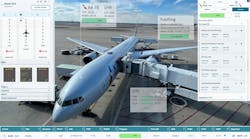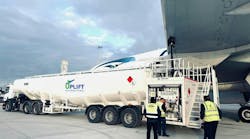The COVID-19 pandemic abruptly stalled air travel activity beginning in March 2020, resulting in the largest financial loss ever recorded by Halifax International Airport Authority (HIAA).
This, and other details about how the pandemic affected HIAA and its plans for recovery, were presented today at its Annual Public Meeting, held virtually to comply with COVID-19 provincial public health protocols.
“In the 21-years HIAA has managed Halifax Stanfield, 2020 can easily be described as the most challenging year the airport has ever faced,” said Joyce Carter, president and CEO, HIAA. “We quickly responded to the pandemic by supporting public health measures and travel restrictions, we implemented enhanced health and safety protocols, and we continued to, as always, put all our focus on safe airport operations. The drastic decline in activity, however, has eliminated most of our revenue streams and due to the lack of meaningful government support, we have been required to take on more debt to ensure this critical piece of transportation infrastructure remains open for our industry partners and community members.”
Pre-pandemic, Halifax Stanfield was home to 120 organizations supporting 5,600 jobs on-site, such as ground handlers, firefighters, accountants, hotel employees, aircrew, and more. A significant economic driver, contributing over $3.8 billion annually to the Nova Scotia economy, the airport plays an important role in supporting tourism, trade, investment, and immigration throughout the region.
“HIAA has worked incredibly hard over the past two decades, with its partners, stakeholders, community members, and government, to put Halifax Stanfield on the map,” said Carter. “COVID-19 has certainly stalled the progress we’ve made, but we’re confident we will be ready to contribute to the success and recovery of our region, once the pandemic subsides.”
As a locally controlled, not-for-profit organization, HIAA exists to serve its communities and ensure they have the air service links necessary to grow and thrive. HIAA leases the airport property from the federal government and pays rent for the right to manage, operate, and develop the airport in a way that supports economic development for our region.
“Our organization is intended to be self-sustaining from a financial perspective,” said Paul Brigley, vice president, finance and chief financial officer. “Our fees are set to cover our costs, and any surplus we generate in a normal year is reinvested into the airport. The pandemic has eliminated surpluses and with dramatically reduced revenue we were left to rely on borrowing to support operations for the better part of 2020. We’ve taken the steps necessary to ensure we have adequate access to liquidity to continue to operate and provide service to the community until travel demand recovers and airport activity returns to a financially sustainable level.”
HIAA undertook a bondholder consent solicitation in late 2020 seeking permission from existing bondholders to waive certain debt compliance provisions contained within its master trust indenture for the years 2020 to 2022, which was approved. This provided HIAA with the flexibility needed to address ongoing liquidity concerns given the continued uncertainty associated with the pandemic and when non-essential air travel can safely restart.
Earlier this week, HIAA closed a new $150 million private placement bond issue providing the additional liquidity needed to maintain operations and required capital investment over the next few years, as our industry recovers from the impact of the COVID-19 pandemic.
Despite the significant loss in revenue, Halifax Stanfield remains open 24/7 to facilitate critical medical and military flights, unexpected emergencies such as flight diversions, and air cargo deliveries of important goods and supplies, such as vaccines.
Although 2020 was not a record-breaking year for air cargo activity, cargo was affected to a lesser degree than passenger volumes. Cargo processed at Halifax Stanfield in 2020 was just under 33,000 metric tonnes, a decrease of 19 percent compared to 2019.
HIAA saw a modest increase in cargo flight landings in 2020 and the new Air Cargo Logistics Park continued to advance, with the construction of new aircraft parking aprons and a cargo warehouse facility. The Air Cargo Logistics Park was made possible with financial support totaling $18 million from the Federal Government through the National Trade Corridors Fund, and $5 million from the Province of Nova Scotia, along with HIAA’s investment of $13 million.
“While there was less overall aviation activity in 2020 than in years past, the work that’s done at Halifax Stanfield is critical to keeping our economy growing and communities connected,” said Carter. “We are incredibly proud of everyone in the Halifax Stanfield community for their perseverance, both personally and professionally, as we collectively navigate immense uncertainty and unknown territory.”
“We are working together with a vision of a brighter future. We are staying the course.”
Key Highlights from HIAA’s 2020 Annual Report:
• In 2020, Halifax Stanfield served 995,426 passengers, down from 4,188,443 in 2019. Two-thirds of all 2020 passengers travelled between January and March.
• Halifax Stanfield expected to have 17 airlines operating to 46 destinations in Canada, the U.S., the Caribbean, Mexico, and Europe. Throughout the pandemic, the airport was served by only three airlines flying to eight domestic destinations.
• HIAA’s total revenue in 2020 was $41.3 million, down from $114.4 million from 2019.
• Expenses exceeded revenue by $40.1 million in 2020, an unprecedented change from the surplus of revenue over expenses of $7.5 million reported in 2019.
• Halifax Stanfield responded quickly to the pandemic, implementing new health and safety enhancements inside the airport which have been reviewed and certified by Airports Council International, for meeting globally recognized best practices for healthy airports.
• There is significant uncertainty around when air travel will start to safely recover, however, HIAA predicts it will take four to five years to return to 2019 levels.



